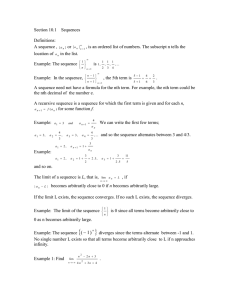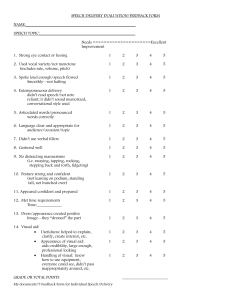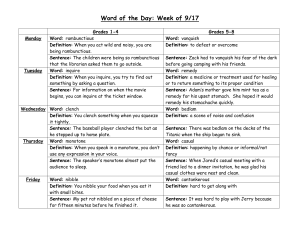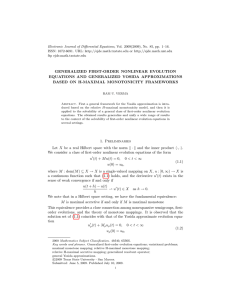Electronic Journal of Differential Equations, Vol. 2011 (2011), No. 50,... ISSN: 1072-6691. URL: or
advertisement
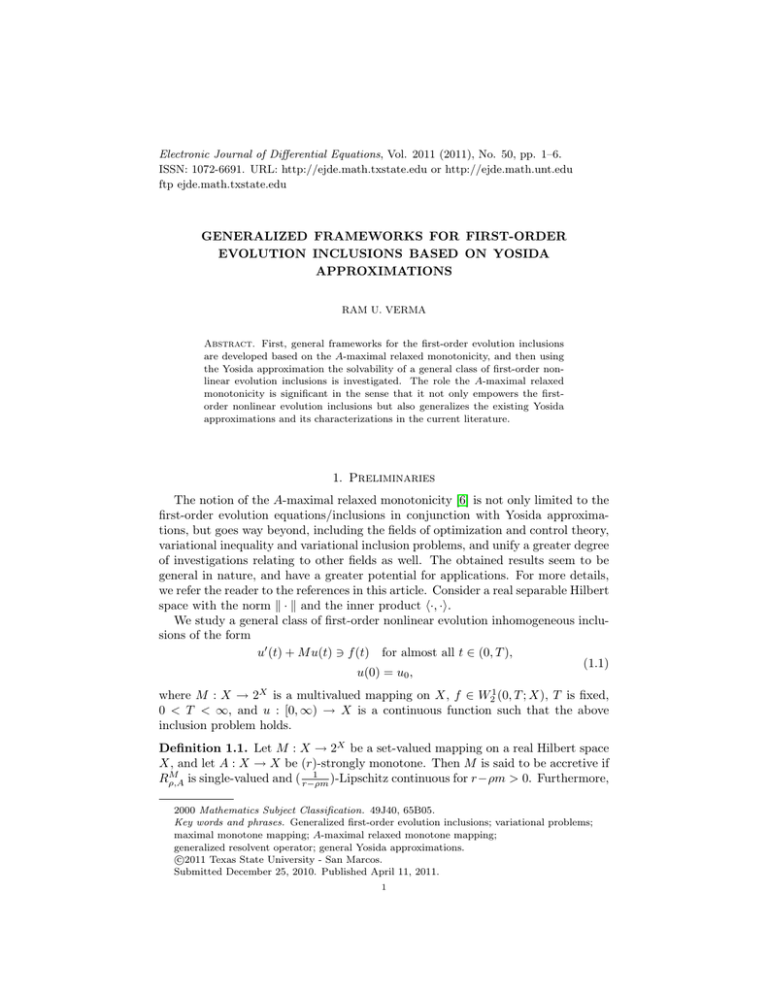
Electronic Journal of Differential Equations, Vol. 2011 (2011), No. 50, pp. 1–6. ISSN: 1072-6691. URL: http://ejde.math.txstate.edu or http://ejde.math.unt.edu ftp ejde.math.txstate.edu GENERALIZED FRAMEWORKS FOR FIRST-ORDER EVOLUTION INCLUSIONS BASED ON YOSIDA APPROXIMATIONS RAM U. VERMA Abstract. First, general frameworks for the first-order evolution inclusions are developed based on the A-maximal relaxed monotonicity, and then using the Yosida approximation the solvability of a general class of first-order nonlinear evolution inclusions is investigated. The role the A-maximal relaxed monotonicity is significant in the sense that it not only empowers the firstorder nonlinear evolution inclusions but also generalizes the existing Yosida approximations and its characterizations in the current literature. 1. Preliminaries The notion of the A-maximal relaxed monotonicity [6] is not only limited to the first-order evolution equations/inclusions in conjunction with Yosida approximations, but goes way beyond, including the fields of optimization and control theory, variational inequality and variational inclusion problems, and unify a greater degree of investigations relating to other fields as well. The obtained results seem to be general in nature, and have a greater potential for applications. For more details, we refer the reader to the references in this article. Consider a real separable Hilbert space with the norm k · k and the inner product h·, ·i. We study a general class of first-order nonlinear evolution inhomogeneous inclusions of the form u0 (t) + M u(t) 3 f (t) for almost all t ∈ (0, T ), (1.1) u(0) = u0 , where M : X → 2X is a multivalued mapping on X, f ∈ W21 (0, T ; X), T is fixed, 0 < T < ∞, and u : [0, ∞) → X is a continuous function such that the above inclusion problem holds. Definition 1.1. Let M : X → 2X be a set-valued mapping on a real Hilbert space X, and let A : X → X be (r)-strongly monotone. Then M is said to be accretive if 1 M Rρ,A is single-valued and ( r−ρm )-Lipschitz continuous for r−ρm > 0. Furthermore, 2000 Mathematics Subject Classification. 49J40, 65B05. Key words and phrases. Generalized first-order evolution inclusions; variational problems; maximal monotone mapping; A-maximal relaxed monotone mapping; generalized resolvent operator; general Yosida approximations. c 2011 Texas State University - San Marcos. Submitted December 25, 2010. Published April 11, 2011. 1 2 R. U. VERMA EJDE-2011/50 M M is m-accretive (or A-maximal accretive) if M is accretive and Rρ,A exists for M every ρ > 0 on X, where Rρ,A is the resolvent of M . Lemma 1.2. Let M : X → 2X be a set-valued mapping on a real Hilbert space X. Then following properties are equivalent: (i) M is monotone. (ii) M is accretive. Lemma 1.3. Let M : X → 2X be a set-valued mapping on a real Hilbert space X. Then we have the following implications equivalent: (i) M is A-maximal relaxed monotone. (ii) M is monotone and R(A + ρM ) = X. (iii) M is m-accretive. We plan to explore the solvability of the inclusion problem (1.1) based on the notion of the A-maximal relaxed monotonicity [6] and the generalized Yosida approximations. The generalized Yosida approximation turns out to be Lipschitz continuous, while we explore the solvability of the inclusion problem (1.1). The obtained results seem to be application-enhanced to problems arising from other fields, including optimization theory, decision and management sciences, engineering science, variational inequality and variational inclusion problems. There are also some detailed results that are investigated on the generalized Yosida approximations to the context of the A-maximal relaxed monotonicity frameworks. For more details, we refer the reader to the references in this article. 2. Auxiliary results Definition 2.1. Let A : X → X be an (r)-strongly monotone single-valued mapping and M : X → 2X be a set-valued mappings. The map M : X → 2X is said to be A-maximal relaxed monotone if (i) M is (m)-relaxed monotone; i.e., hu∗ − v ∗ , u − vi ≥ −mku − vk2 ∀(u, u∗ ), (v, v ∗ ) ∈ M, (ii) R(A + ρM ) = X for ρ > 0. Definition 2.2. Let A : X → X be a single-valued mapping and M : X → 2X be a set-valued mapping. Let A be (r)-strongly monotone. The map M is said to 1 be accretive iff (A + ρM )−1 is single-valued and (A + ρM )−1 is ( r−ρm )-Lipschitz continuous for all ρ > 0 and r − ρm > 0. Proposition 2.3 ([6]). Let A : X → X be a single-valued mapping, and M : X → 2X be a set-valued mapping such that D(A) ∩ D(M ) 6= ∅. Let A be (r)strongly monotone, and let M be an A-maximal relaxed monotone mapping. Then the generalized resolvent operator associated with M and defined by M Rρ,A (u) = (A + ρM )−1 (u) ∀ u ∈ X, 1 is ( r−ρm )-Lipschitz continuous. M Next, we generalize the Yosida approximation Mρ by Mρ = ρ−1 (I − ARρ,A ), where A : X → X is an (r)-strongly monotone mapping on X for ρ > 0, and for M Rρ,A = (A + ρM )−1 , which reduces to the Yosida approximation of M for A = I: Mρ = ρ−1 (I − RρM ), EJDE-2011/50 GENERALIZED FRAMEWORKS 3 where I is the identity and RρM = (I + ρM )−1 . Lemma 2.4. Let A : X → X and M : X → 2X be mappings such that D(A) ∩ M D(M ) 6= ∅. Let A be (r)-strongly monotone and AoRρ,A be cocoercive, and let M be an A-maximal relaxed monotone mapping. Then the generalized Yosida approximation Mρ of M defined by M Mρ = ρ−1 (I − ARρ,A ), where M Rρ,A (u) = (A + ρM )−1 (u) is ( ρ1 )-Lipschitz ∀ u ∈ D(A) ∩ D(M ), continuous. Proof. For any u, v ∈ X, we have hMρ (u) − Mρ (v), u − vi = hMρ (u) − Mρ (v), ρ[Mρ (u) − Mρ (v) − (Mρ (u) − Mρ (v))] + u − vi = ρkMρ (u) − Mρ (v)k2 M M M M − hρ−1 [u − v − (ARρ,A (u) − ARρ,A (v))], −(ARρ,A (u) − ARρ,A (v))i M M = ρkMρ (u) − Mρ (v)k2 + ρ−1 hu − v, ARρ,A (u) − ARρ,A (v)i M M M M − ρ−1 hARρ,A (u) − ARρ,A (v), ARρ,A (u) − ARρ,A (v)i M M ≥ ρkMρ (u) − Mρ (v)k2 + ρ−1 kARρ,A (u) − ARρ,A (v)k2 M M − ρ−1 kARρ,A (u) − ARρ,A (v)k2 ≥ ρkMρ (u) − Mρ (v)k2 . For A = I, Lemma 2.4 reduces to Lemma 2.5. Let M : X → 2X be a set-valued mapping. Let M be a maximal monotone mapping. Then the Yosida approximation Mρ of M defined by Mρ = ρ−1 (I − RρM ), where RρM (u) = (I + ρM )−1 (u) ∀ u ∈ D(M ), is ( ρ1 )-Lipschitz continuous. Proposition 2.6. Let A : X → X and M : X → 2X be mappings such that M D(A) ∩ D(M ) 6= ∅. Let A be (r)-strongly monotone and AoRρ,A be cocoercive, and let M be an A-maximal relaxed monotone mapping. Then the generalized Yosida M approximation Mρ of M defined by Mρ = ρ−1 (I − ARρ,A ), satisfies: M (i) Mρ (u) ∈ M Rρ,A (u). (ii) Mρ is A-maximal relaxed monotone. (iii) (Mλ )µ = Mλ+µ . Proof. To prove (i), consider M w = Rρ,A (u) ⇒ u ∈ (A + ρM )(w) ⇒ ρMρ (u) = u − A(w) ∈ ρM (w). The proofs of (ii) and (iii) follow, respectively, from the Lipschitz continuity of the M generalized resolvent Rρ,A (u) and the definition of Mρ . 4 R. U. VERMA EJDE-2011/50 Proposition 2.7. Let A : X → X and M : X → 2X be mappings such that M D(A) ∩ D(M ) 6= ∅. Let A be (r)-strongly monotone and AoRρ,A be cocoercive, and let M be an A-maximal relaxed monotone mapping. Then the generalized Yosida M approximation Mρ of M defined by Mρ = ρ−1 (I − ARρ,A ), satisfies: for all u ∈ D(M ), Mρ (u) → M0 (u), kMρ (u)k ↑ kM0 (u)k kMρ (u) − M0 (u)k2 ≤ kM0 (u)k2 − kMρ (u)k2 as ρ ↓ 0, for all ρ > 0. 3. Generalized First-Order Evolution Inclusions Let A : X → X be a single-valued mapping, and M : X → 2X be a multivalued mapping. In this section, we consider the solvability of first-order nonlinear evolution inclusions of the form u0 (t) + M u(t) 3 f (t) for almost all t ∈ (0, T ) (3.1) u(0) = u0 , where M : X → 2X is a multivalued mapping on X, f ∈ W21 (0, T ; X), T is fixed, 0 < T < ∞, and u : [0, ∞) → X is a continuous function such that (3.1) holds. Here M is A-maximal relaxed monotone and the Yosida approximation of M is defined by M )). Mρ = ρ−1 (I − A(Rρ,A We consider the main result on the first-order evolution inclusions based on Amaximal relaxed monotonicity framework in conjunction with generalized Yosida approximations. Theorem 3.1. Let A : X → X be (r)-strongly monotone, and let M : X → 2X M be be A-maximal relaxed monotone on a separable Hilbert space X. Let AoRρ,A −1 M cocoercive, where Rρ,A ) = (A + ρM ) for ρ > 0. Suppose that the given u0 ∈ D(M ), f ∈ W21 (0, T ; X) are fixed. Then (3.1) has exactly one solution u ∈ W21 (0, T ; X) such that M : X → 2X is A-maximal relaxed monotone. Proof. The proof is based on the results from Section 2, especially Lemma 2.4 and Proposition 2.3. First, we consider the regularized problems u0ρ (t) + Mρ uρ (t) = f (t), uρ (0) = u0 , ρ > 0. (3.2) As the function f is continuous on [0,T] by the hypotheses, and Mρ is ( ρ1 )-Lipschitz continuous by Lemma 2.4, problems (3.2) can be solved as for first-order evolution equations. To achieve that goal, we need to arrive at a priori estimate ku0ρ (t)k ≤ C ∀ ρ > 0, t ∈ [0, T ]. (3.3) Now we differentiate (3.2) by setting gρ (t) = Mρ ouρ (t) as follows: u00ρ (t) + gρ0 (t) = f 0 (t) for almost all t. (3.4) M Under the hypotheses all the derivatives exist. Since A ◦ Rρ,A is cocoercive (and M hence A ◦ Rρ,A is nonexpansive), it implies M M hA(Rρ,A (u)) − A(Rρ,A (u)), u − vi ≤ ku − vk2 . EJDE-2011/50 GENERALIZED FRAMEWORKS 5 It follows that Mρ is monotone, and thus we have hMρ uρ (t + h) − Mρ uρ (t), uρ (t + h) − uρ (t)i ≥ 0. It follows that hgρ0 (t), u0ρ (t)i ≥ 0. Therefore, hu00ρ (t), u0ρ (t)i ≤ −hgρ0 (t), u0ρ (t)i + hf 0 (t), u0ρ (t)i ≤ hf 0 (t), u0ρ (t)i ≤ kf 0 (t)k ku0ρ (t)k 1 1 ≤ kf 0 (t)k2 + ku0ρ (t)k2 . 2 2 00 0 Applying integration by parts to huρ (t), uρ (t)i, we have Z t 2 hu00ρ (s), u0ρ (s)ids = ku0ρ (t)k2 − ku0ρ (0)k2 0 Z t ≤ kf k2Y + ku0ρ (s)k2 ds, 0 where Y = W21 (0, T ; X). This is equivalent to ku0ρ (t)k2 − ku0ρ (0)k2 ≤ kf k2Y Z + t ku0ρ (s)k2 ds, 0 where Y = W21 (0, T ; X). Now by Gronwall lemma, ku0ρ (t)k2 ≤ c(ku0ρ (0)k2 + kf k2Y ). Finally, using (3.2), we have u0ρ (0) = −Mρ (u0 ) + f (0) and kMρ u0 k ≤ kM0 u0 k, and thus, it follows that (3.3) holds. Corollary 3.2. Let M : X → 2X be maximal monotone on a separable Hilbert space X. Suppose that the given u0 ∈ D(M ), f ∈ W21 (0, T ; X) are fixed. Then (3.1) has exactly one solution u ∈ W21 (0, T ; X) such that M : X → 2X is maximal monotone. Concluding Remarks. The obtained results on the first-order evolution inclusions can further be generalized to the case of a real Banach space setting in terms of accretivity and m-accretivity. More importantly, the solution concept is also changed as an integral solution based on the difference method belonging to (3.1) as backward differences. The uniqueness proof assures that each classical solution of (3.1) is also an integral solution. References [1] Ahmed, N. U.; Optimization and Identification of Systems Governed by Evolution Equations on Banach Spaces, Pitman Research Notes in Mathematics, Volume 184, Longman Scientific and Technical, 1988. [2] Fang, Y. P.; Huang, N. J.; H-monotone operators and system of variational inclusions, Communications on Applied Nonlinear Analysis 11 (1) (2004), 93–101. [3] Komura, Y.; Nonlinear semigroups in Hilbert space, Journal of Mathematical Society of Japan 19 (1967), 493–507. 6 R. U. VERMA EJDE-2011/50 [4] Nakajo,k; Takahashi, W.; Strong convergence theorems for nonxpansive mappings and nonexpansive semigroups, Journal of Mathematical Analysis and Applications 279 (2003), 372–379. [5] Verma, R. U.; A-monotonicity and applications to nonlinear inclusion problems, Journal of Applied Mathematics and Stochastic Analysis 17 (2004), 193–195. [6] Verma, R. U.; A-monotonicity and its role in nonlinear variational inclusions, Journal of Optimization Theory and Applications 129 (3)(2006), 457–467. [7] Verma, R. U.; First-order evolution equations and Yosida approximations based on the relative maximal monotonicity, International Journal of Evolution Equations 5 (2) (2010), 1–19. [8] Verma, R. U.; General system of A-monotone nonlinear variational inclusions with applications, Journal of Optimization Theory and Applications 131 (1) (2006), 151–157. [9] Verma, R. U.; Approximation solvability of a class of nonlinear set-valued inclusions involving (A, η)-monotone mappings, Journal of Mathematical Analysis and Applications 337 (2008), 969–975. [10] Yosida, K.; On differentiability and the representation of one-parameter semigroups of linear operators, Journal of Mathematical Society of Japan 1 (1948), 15–21. [11] Yosida, K.; Functional Analysis, Springer-Verlag, Berlin, 1965. [12] Zeidler, E.; Nonlinear Functional Analysis and its Applications I, Springer-Verlag, New York, New York, 1984. [13] Zeidler, E.; Nonlinear Functional Analysis and its Applications II/A, Springer-Verlag, New York, New York, 1990. [14] Zeidler, E.; Nonlinear Functional Analysis and its Applications II/B, Springer-Verlag, New York, New York, 1990. [15] Zeidler, E.; Nonlinear Functional Analysis and its Applications III, Springer-Verlag, New York, New York, 1985. Ram U. Verma Texas A&M University, Department of Mathematics, Kingsville, TX 78363, USA E-mail address: verma99@msn.com


